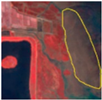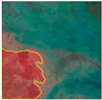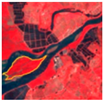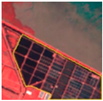Abstract
Coastal blue carbon ecosystems (traditional types such as mangroves, salt marshes, and seagrass meadows; emerging types such as tidal flats and mariculture) play pivotal roles in capturing and storing atmospheric carbon dioxide. Reliable assessment of the spatial and temporal variation and the carbon storage potential holds immense promise for mitigating climate change. Although previous field surveys and regional assessments have improved the understanding of individual habitats, most studies remain site-specific and short-term; comprehensive, multi-decadal assessments that integrate all major coastal blue carbon systems at the national scale are still scarce for China. In this study, we integrated 30 m Landsat imagery (1992–2022), processed on Google Earth Engine with a random forest classifier; province-specific, literature-derived carbon density data with quantified uncertainty (mean ± standard deviation); and the InVEST model to track coastal China’s mangroves, salt marshes, tidal flats, and mariculture to quantify their associated carbon stocks. Then the GeoDetector was applied to distinguish the natural and anthropogenic drivers of carbon stock change. Results showed rapid and divergent land use change over the past three decades, with mariculture expanded by 44%, becoming the dominant blue carbon land use; whereas tidal flats declined by 39%, mangroves and salt marshes exhibited fluctuating upward trends. National blue carbon stock rose markedly from 74 Mt C in 1992 to 194 Mt C in 2022, with Liaoning, Shandong, and Fujian holding the largest provincial stock; Jiangsu and Guangdong showed higher increasing trends. The Normalized Difference Vegetation Index (NDVI) was the primary driver of spatial variability in carbon stock change (q = 0.63), followed by precipitation and temperature. Synergistic interactions were also detected, e.g., NDVI and precipitation, enhancing the effects beyond those of single factors, which indicates that a wetter climate may boost NDVI’s carbon sequestration. These findings highlight the urgency of strengthening ecological red lines, scaling climate-smart restoration of mangroves and salt marshes, and promoting low-impact mariculture. Our workflow and driver diagnostics provide a transferable template for blue carbon monitoring and evidence-based coastal management frameworks.
1. Introduction
Blue carbon ecosystems, encompassing mangroves, salt marshes, and seagrass meadows, play vital roles in capturing and storing carbon dioxide, with less than 0.2% of the global ocean surface, while accounting for roughly 50% of the organic carbon buried in marine sediments, holding immense promise for mitigating climate change [1,2]. These habitats not only underpin coastal protection but also play a vital role in fishery productivity, food security, and coastal livelihoods [3,4]. Recent studies have shown that macroalgae, shellfish, microorganisms, and tidal flats in coastal areas are also significant reservoirs in carbon fixation and storage [5,6]. These ecosystems are highly efficient at sequestering carbon dioxide, often storing more carbon per unit area than terrestrial forests [7], underscoring their importance for meeting global temperature goals and achieving national carbon neutrality pledges. However, blue carbon ecosystems are experiencing rapid degradation due to coastal development pressures and climate change challenges such as climate extremes and the rising sea level [8,9]. For instance, 50% of salt marshes and 35% of mangroves globally have been lost since the mid-20th century [10], underscoring the need for immediate research. Experts have identified critical research questions within blue carbon science, particularly emphasizing the need to elucidate the spatiotemporal distribution of blue carbon ecosystems and reduce uncertainties in assessments [11].
Research on traditional blue carbon ecosystems has progressed markedly, refining our knowledge of their spatial distribution, sequestration rates, and vulnerability to environmental changes [12,13]. Mangroves remain the most intensively studied habitat because of their complex structure (including above-ground biomass and below-ground soil carbon) and high carbon storage capacity, leading to a relatively comprehensive understanding of their patterns [14,15]. Salt marsh research is also relatively mature, with particular emphasis on the storage and accumulation of soil organic carbon [16]. Fewer studies target seagrass meadows, largely owing to their patchy distribution and the difficulty of sampling below-ground biomass [17]. Despite the progress, discrepancies in distribution and area for blue carbon ecosystem estimates persist across studies due to data sources, technical constraints, and regional bias [18,19]. Moreover, research on tidal flats and mariculture is only beginning to receive attention. Although tidal flats are emerging as promising agents of carbon reservoirs with their sediments’ carbon stock, most assessments remain focused on regional assessments, and the overall understanding is not yet comprehensive [20]. Research on mariculture (e.g., bivalve shellfish and seaweed farming) has principally focused on carbon footprint and emissions rather than carbon stock [21], leaving its blue carbon sequestration potential underexplored. Accordingly, there is a pressing need for systematically clarifying the long-term dynamics of various blue carbon ecosystems at large scales with more precise quantification methods and further exploration of the potential in carbon storage for both traditional and emerging blue carbon ecosystems.
The methods for monitoring blue carbon ecosystems and estimating their carbon stocks are diverse. For example, field sampling approaches, characterized by labor-intensive and time-consuming methods, can directly measure biomass and soil carbon and provide high-precision data, but are limited by spatial coverage [22]. Statistical yearbooks and administrative reports provide national or provincial extent estimates of blue carbon areas, but are insufficient for capturing fine-scale spatial variations [23]. Remote sensing has therefore become indispensable for blue carbon ecosystem monitoring, providing spatially explicit, repeatable observations over multi-decadal periods [24,25]. Among various available sensors, the Landsat series is most widely used in large-scale, long-term blue carbon mapping [26,27]. Moreover, recent cloud-computing platforms such as Google Earth Engine (GEE) have greatly improved the efficiency of remote sensing analyses [28]. Carbon stock calculation estimation methods are equally varied. Early studies often relied on regional-specific biomass and soil-profile data, producing static outcomes that ignore landscape change [29]. More recently, the Integrated Valuation of Environmental Services and Tradeoffs (InVEST) model, which can reflect dynamic spatiotemporal carbon stock changes and integrate well with 3S (remote sensing, GIS, and GPS) technology, has been more widely applied [30,31]. In addition to the gaps remaining in capturing long-term dynamics of blue carbon ecosystems and precise methods in quantifying carbon stock, the relative influence of different factors driving blue carbon ecosystem changes has not been well understood. The influence of multiple natural factors and human activities, such as climate change, coastal urbanization, offshore eutrophication, and coastal erosion, needs to be further clarified to distinguish the main contributor [32,33].
China’s coastline, spanning over 32,000 km (mainland coastline over 18,000 km, and island coastline over 14,000 km), supports an exceptionally diverse array of blue carbon ecosystems. This makes the country an ideal natural study area for evaluating how such ecosystems can contribute to its 2060 carbon-neutrality commitment [34]. Research on these ecosystems assessing their carbon stock potential, serving as a nature-based solution, is urgent for achieving emission reduction targets. Although many studies have attempted to assess the status of coastal blue carbon resources in China [35,36], inconsistencies in survey methods, equipment, and the lack of consistent long-term data from uniform sources have produced highly divergent area estimates, hindering reliable stock assessments. Despite some progress in assessing the extent and carbon stock of blue carbon ecosystems in specific provinces or islands in China [37,38], it is essential to clarify the spatiotemporal evolution of coastal blue carbon ecosystems in China over the past decades and reveal the key natural and anthropogenic drivers that shape their changes. Such knowledge will not only enhance the global understanding of blue carbon dynamics but also inform China’s policy making and management strategies to effectively utilize these ecosystems on its path to carbon neutrality.
To address the knowledge gaps mentioned above, we systematically analyzed the dynamic change in both traditional and emerging coastal blue carbon ecosystems in China, including mangroves, salt marshes, tidal flats, and mariculture, over the past 30 years. This study aims to (1) providing high-resolution maps of blue carbon ecosystems based on 30 m Landsat imagery processed in GEE with a random-forest classifier, achieving high accuracy; (2) clarify the spatiotemporal evolution of carbon stock for the blue carbon ecosystem using province-specific carbon density data with uncertainty range, collected from multiple published papers, and employing the InVEST model; and (3) distinguish the dominant driver of carbon stock change using the factor and interaction modules of the GeoDetector model to identify how natural and anthropogenic factors jointly shape carbon stock change. This integrated framework delivers nationally comparable, long-term estimates that improve on earlier site-specific or single-habitat studies. In addition, it can be transferred to other coastal regions for blue carbon assessment and management.
2. Materials and Methods
2.1. Materials
The remote sensing data employed for this research includes the Landsat 5 TM and 8 OLI atmospherically corrected surface reflectance (SR) dataset spanning from 1992 to 2022 (annual data with a 5-year interval) at 30 m spatial resolution, together with 30 m Shuttle Radar Topography Mission (SRTM) Digital Elevation Model (DEM) data. It should be noted that Landsat 5 data in 2011 were used for analysis, as some strips of Landsat 7 images are missing. The details of these remote sensing data are provided in Table 1. The study region (Figure 1) covers 62 blocks of the Landsat Worldwide Reference System (WRS-2) (Figure S1).

Table 1.
Basic information of remote sensing images.
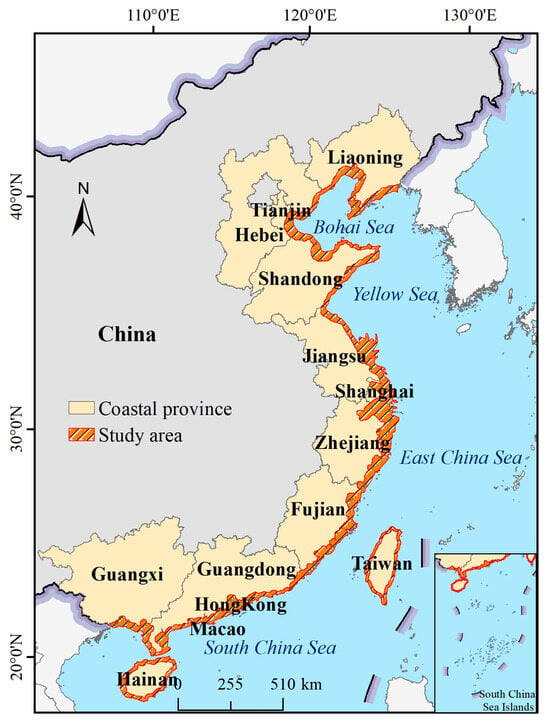
Figure 1.
Study area.
Carbon density values are fundamental to quantifying an ecosystem’s carbon sequestration capacity [39,40]. In this study, carbon density data of coastal China were sourced from extensive bibliometric analyses [41,42,43]; these data were provided at the provincial scale to ensure the accuracy of the carbon stock assessment. Specifically, we conducted a systematic bibliographic search in Web of Science (English literature) and CNKI (Chinese literature). The query combined the terms “China”, “coastal”, “blue carbon”, “soil”, “plant”, “vegetation”, “biomass”, “carbon storage”, “carbon stock”, “carbon density”, etc. The initial search returned nearly 800 papers. We retained studies that (1) were based on field sampling, (2) investigated at least one of the targeted blue carbon ecosystem types, and (3) reported at least one kind of carbon density data. After screening, 94 peer-reviewed articles remained, providing carbon data for 14 coastal provinces. When the number of carbon density data points for a specific blue carbon in a province exceeds 1, we provide the mean ± standard deviation values derived from relevant studies. The parameters of mangroves (Table 2), salt marshes (Table 3), and tidal flats (Table S1) include carbon measurements of plant biomass, soil organic carbon, and litter pools.

Table 2.
Carbon density data of mangroves in coastal China.

Table 3.
Carbon density data of salt marshes in coastal China.
Mariculture species in coastal China are dominated by shellfish and macroalgae. Recent studies suggest that shellfish aquaculture and macroalgal farming can also act as net carbon sinks when a significant fraction of shell carbonate or detached algal biomass is permanently buried or exported to deep water [44,45]. The carbon sequestration mechanism for shellfish is mainly reflected in the total amount of carbon contained in shell carbonate and soft tissues, whereas for macroalgae it is the accumulation of carbon contained within their biomass [46,47]. Thus, the carbon density of mariculture for each province was obtained by bibliometric analysis with statistics on the species composition of aquaculture production (Table S2).
2.2. Methodology of Land Use Classification and Validation
2.2.1. Preprocessing and Land Use Classification of Remote Sensing Data
All preprocessing, such as image acquisition, cloud masking, and compositing, as well as land use classification of remote sensing data, were performed on the GEE platform (https://developers.google.cn/earth-engine/ (accessed on 15 May 2023)) [48]. Specifically, for data preprocessing, the following steps were implemented: (1) selecting appropriate remote sensing data and classification years, (2) using the CFMask algorithm to generate the quality assessment (QA) band for cloud masking, (3) applying the ee.Terrain.hillShadow function to remove terrain shadows, (4) clipping the images to the study area using the Clip function, and (5) calculating relevant vegetation indices using the normalized difference algorithm [49].
This study focuses on both the traditional blue carbon ecosystems and the new objects that have recently attracted attention in the blue carbon sink. However, due to the limitation of penetration ability underwater for the Landsat series and its spatial resolution, the spatial distribution of seagrass meadows is difficult to accurately identify, especially for those with fragmented or patchy distributions [50,51]. Previous studies have shown that the carbon stock of seagrass meadows in China is nearly 20% of mangrove stock and 6% of salt marshes, indicating that their exclusion would introduce only a minor downward bias at the national scale [52]. Therefore, this study extracted the four typical blue carbon ecosystems in coastal China, including mangroves, salt marshes, tidal flats, and mariculture. In addition, six land use types of non-blue carbon ecosystems, that is, cropland, forest, grassland, water, non-used land, and construction land, are also included for a full assessment of coastal land use and carbon transitions. The land use transition from 1992 to 2022 (5-year interval) was computed and visualized as a Sankey diagram; nodes represent each land use class at each epoch, and ribbon color equals the source class to maintain visual continuity. The remote sensing interpretation markers of the above four types are established based on GEE satellite images (Table 4).

Table 4.
Image interpretation marks of coastal blue carbon ecosystems.
2.2.2. Extraction of Classification Feature Information
To improve land-cover classification performance, 17 variables were extracted from multi-source datasets, encompassing four primary feature categories [53,54]. Those are the raw spectral band, spectral index, texture features, and topographic features (the elevation and slope were obtained from DEM data) (Table 5).

Table 5.
The details of the feature information for land use classification.
2.2.3. Random Forest-Based Classification and Accuracy Evaluation
The land use classification of coastal China was produced by the random forest algorithm, which aggregates multiple decision trees trained on bootstrap samples to generate robust predictions. This algorithm demonstrates remarkable advantages in terms of requirements for sample size, the degree of human–computer interaction intervention, and classification accuracy [55]. It is therefore well suited to the classification of heterogeneous coastal landscapes. To explore the impact of variable selection on classification accuracy, we utilized the Random Forest Classifier on the GEE to obtain the importance ranking of 17 features. Results show that the top five most influential variables in the model were mNDWI, NDVI, SAVI, band red, and brightness (Figure S2). To analyze the influence of quantity in feature selection on classification accuracy, all 17 variables, the top 10, and the top 5 variables in terms of importance are, respectively, used as input values to compare classification accuracies under different conditions [56]. Moreover, during the construction of the random forest, there are two key parameters, i.e., the number of decision trees (ntree) and the number of predictor variables randomly selected at each decision tree node (mtry). These two parameters significantly affect classification accuracy. In this study, the value range of ntree is set from 100 to 500, and it is adjusted in steps of 100. The value of mtry alternates between 3, 4, and 5 [57]. By setting the above parameters, this study explored the impact of different parameter combinations on model performance and thereby determined the optimal configuration. The training and validation samples used for model construction were point-based, with each point corresponding to a single pixel location. The total number of reference points each year is 3350, detailed counts for each of the ten classes are provided in Table S3. To evaluate the accuracy of random forest classification, we adopted the internal cross-validation method, with 80% of the data randomly selected for classification training, and 20% used for validation. The overall accuracy (OA) and Kappa coefficient were employed as evaluation indicators for classification accuracy.
2.3. Carbon Stock Estimation Based on the InVEST Model and Its Applicability
The Integrated Valuation of Ecosystem Services and Trade-offs (InVEST) model is a highly functional and practical tool, including multiple modules such as habitat quality assessment, environmental risk evaluation, marine water quality analysis, and carbon stock accounting [58]. The InVEST carbon module has already been applied to assessing blue carbon in coastal reclamation zones in China [59], salt-marsh monitoring in the Yangtze estuary [60], mangrove dynamics in Hainan [61], and the wetland in Liaohe Estuary [62], demonstrating its adaptability once local coefficients are supplied. In this study, the InVEST model has been localized to the provincial level with specific carbon density coefficients for each blue carbon ecosystem; these data were derived through bibliometric analysis (Table 2, Table 3, Tables S1 and S2). Combining the land use classification results and carbon density data, the carbon stock in China’s coastal blue carbon ecosystems was assessed through the InVEST model.
Here, is the carbon stock of grid x at time t; j denotes the different land use classification; A denotes the coverage of land use categories; and , , , and represent the density of above-ground biomass carbon, below-ground biomass carbon, soil carbon, and litter carbon of land use type j.
A one-at-a-time sensitivity analysis was conducted as stress tests for the InVEST model to assess blue carbon in coastal China. The input data required to run the model is modified to observe the changes in the model output. Considering the two main variables affecting the model results, namely the area of blue carbon ecosystems, i.e., mangroves, salt marshes, tidal flats, mariculture, and the carbon density of these ecosystems, including , , , and , the following modifications are made to the model: (1) change 74% (representing the largest quartile polygons) of the area of the tidal flat in the base year (1992) into salt marshes to mimic an extreme but physically plausible ecosystem transition scenario; (2) multiply the carbon density values of each ecosystem type by 100.
2.4. Driving Force Analysis of Carbon Stock Change Based on GeoDetector
The GeoDetector is a spatially explicit statistical framework designed to quantify geographic stratified heterogeneity and to identify the determinants of that heterogeneity [63,64]. Its underlying premise is based on the assumption that environmental factors affecting the development of a geographical thing are spatially different, and if a specific variable holds a greater impact on the thing, the geographical distribution of explanatory variables is likely to align with that of the target variable. In our research, factor detector and interaction detector modules were used to analyze the primary driving factors influencing the change of carbon stocks in blue carbon ecosystems in coastal China. We applied the Factor Detector to quantify the explanatory power of a single factor (X) on the dependent variable (Y). In this study, Y indicates the change of carbon stock, and X contains 17 different natural and anthropogenic factors with reference to previous studies [65,66]. In terms of natural factors, eight variables were selected, including altitude, slope, aspect, temperature, precipitation, Normalized Difference Vegetation Index (NDVI), soil type, and soil erosion. For example, NDVI is a snapshot of vegetation greenness, which is often treated as a driver of carbon stock change (denser biomass adds carbon) [67,68]. As for anthropogenic factors, nine items were covered, namely gross domestic product (GDP), population density, nighttime light (NTL) data, output value of the primary industry, output value of the secondary industry, fishery production, proportion of construction land, road density, and distance from the nearest port. The q-statistic, which is often called the “power of determinant” in GeoDetector studies, measures how much of the spatial variance of a dependent variable Y is explained by the stratification produced by an explanatory factor X [69]. It is computed as
where is the strata of X or Y, is the number of units in stratum h, is the variance of Y in stratum h, is the total number of units, and is the total variance of Y in the entire region. The q value ranges from 0 to 1, with a higher value implying that X better explains the spatial variation in Y.
In addition, we used the interaction detector to evaluate how pairs of factors jointly influence carbon stock change. By contrasting the q value of each interaction with the individual q values of its component factors, we determined whether the interaction was synergistic or antagonistic. If the interaction effect was approximately equal to the sum of the individual effects, the two factors were regarded as acting independently [64]. The types of different interactions can be divided into five categories (Table 6), where the symbol ‘∩’ denotes the intersection between q(A) and q(B), which could be implemented in GIS by overlaying the two factor layers [64,70,71]. A schematic overview of the full methodological workflow is shown as follows (Figure 2).

Table 6.
Types and classification criteria of different factor interactions.
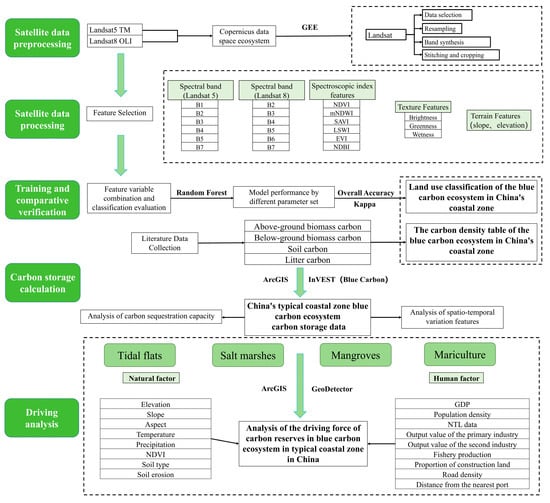
Figure 2.
The methodological flowchart of this study.
3. Results
3.1. Classification of Land Use and Precision Assessment
Based on the comparison analysis on alternative input-variable sets and random forest parameters (ntree, mtry), we found that incorporating sufficient characteristic variables is conducive to improving the classification accuracy (Table 7). For the same set of ntree and mtry, the OA and Kappa coefficients with all 17 features involved are higher than those with only the Top 10 (difference in OA > 4%; Kappa coefficients > 0.04) and Top 5 (difference in OA > 7%; Kappa coefficients > 0.07) variables involved (Table 7). With all 17 features used for classification, the OA ranged from 92.18 to 92.88%, and the Kappa coefficient varied between 0.909 and 0.917. We determined that ntree = 500 and mtry = 3 offered the best balance between accuracy and stability. The out-of-bag (OOB) tests showed that although increasing ntree beyond 300 resulted in only minimal gains in OA, it significantly improved model stability; thus, we adopted it as the preferred setting for land use classification. These highly consistent classification results are reliable for subsequent carbon stock analysis. The land use classification with 10 types of coastal China over the past three decades was obtained (Figure S3). Among the four types of blue carbon categories, mariculture covered the widest spatial range, accounting for 67% of the total area in 2022, followed by tidal flats (27%), salt marshes (4%), and mangroves (2%) (Figure S4).

Table 7.
The overall accuracy (OA) and Kappa coefficient with different settings on input variables, ntree, and mtry.
3.2. Spatiotemporal Pattern of Land Use Change
In the last three decades, the area of mariculture in coastal China has been continuously increasing, from 13,528.46 km2 in 1992 to 19,500.80 km2 in 2022. The growth rates in Fujian, Zhejiang, and Shandong were the most significant, all exceeding 30 km2 per year. Mangroves also showed a fluctuating upward trend (Figure 3a), among which the growth rates in Guangdong and Guangxi are particularly significant (Figure 3b). Salt marshes showed a fluctuating upward trend in coastal China, while in some provinces, such as Jiangsu, Liaoning, and Hebei, their area has decreased slightly. Tidal flats, however, showed a significant downward trend, from 13,080.92 km2 in 1992 to 8016.84 km2 in 2022. Among the coastal provinces, the area in Shandong, Jiangsu, Liaoning, Zhejiang, and Fujian has shrunk particularly significantly (Figure 3). The coastal ecosystem has undergone a drastic process of land use transformation since the 1990s (Figure 4). In terms of the blue carbon ecosystems, mariculture showed pronounced expansion, chiefly occupying land that was formerly cropland, water, and tidal flats. Tidal flats have been replaced mainly by mariculture and water, while a small proportion of water and mariculture has reverted to tidal flats at the same time. Salt marshes primarily transformed into cropland and mariculture, while most newly formed salt marshes have colonized former tidal flats, mariculture, and cropland. Mangroves were supplanted predominantly by mariculture, yet their gains arose from a diverse set of sources, such as tidal flats, water, mariculture, and cropland.
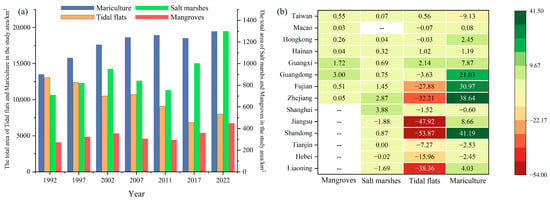
Figure 3.
Area changes in blue carbon ecosystems from 1992 to 2022 for all coastal China (a) and its trend for each coastal province (b).
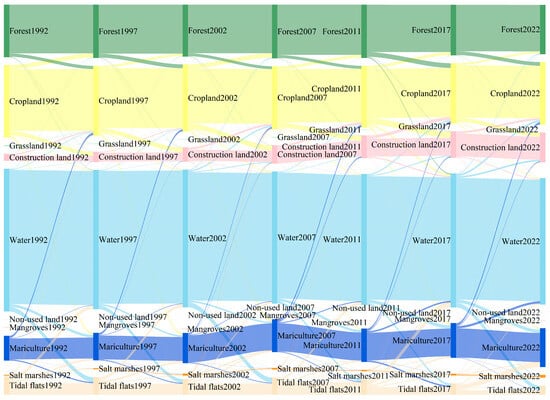
Figure 4.
Sankey diagram of land use transformation of coastal China from 1992 to 2022. Each color represents a type of land use; Nodes represent each land use class at each epoch; ribbons are colored by the source class; thickness is proportional to the transferred area.
The spatial pattern of blue carbon ecosystems in China showed obvious regional heterogeneity (Figure 5). Mariculture was distributed across nearly the entirety of the coastlines, especially concentrated in the eastern and southern coasts, among which Fujian, Zhejiang, and Guangdong took up 49% of the national mariculture areas (Figure S4). Salt marshes occur predominantly in the Yangtze River Delta, where the proportion of Jiangsu, Shanghai, and Zhejiang occupied over 70% of the total marsh extent. Tidal flats are primarily concentrated in Jiangsu, Shandong, Zhejiang, and Liaoning, with Jiangsu alone supporting over 30% of the national total. Mangroves were concentrated in provinces south of Zhejiang. Guangdong contained the largest mangrove area—almost half of the national total—followed by Guangxi and Hainan.
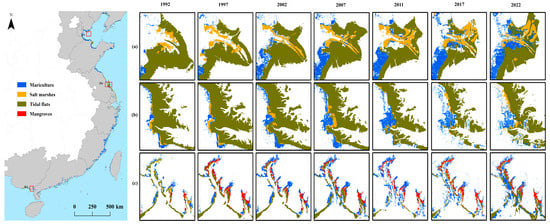
Figure 5.
Spatial pattern of blue carbon ecosystems in coastal China from 1992–2022. The enlarged representative areas (a–c) more clearly reflected the characteristics of changes in three typical areas: (a) Mainly consists of tidal flats, mariculture, and salt marshes; (b) Mainly consists of tidal flats and mariculture; (c) Mainly consists of mangroves and mariculture.
3.3. Spatiotemporal Pattern of Carbon Stock of Blue Carbon Ecosystems
Over the past 30 years, the blue carbon stock in coastal China has shown an overall upward trend, increasing from 74.27 Mt C in 1992 to 194.34 Mt C in 2022, with an annual growth rate of 4.00 Mt C/yr (Figure 6). Each coastal province has shown varied upward trends, among which Fujian and Liaoning showed the fastest growth rates, both exceeding 0.6 Mt C/yr, followed by Jiangsu and Guangdong, with growth rates of approximately 0.5 Mt C/yr. Among all the coastal provinces, Liaoning, Shandong, and Fujian provinces hold the highest carbon stocks, with an average value of over 20 Mt C in the past 30 years, together accounting for nearly 50% of the national total (Figure 6). As for the spatial distribution (Figure 7), the coastal zone in Bohai and the Yellow Sea is the region with the highest blue carbon stock, followed by the East China Sea coastal regions, while the carbon stock in the provinces of the South China Sea is relatively low. The high-value regions are predominantly distributed in areas characterized by dense vegetation, such as mangroves and salt marshes. The primary cause lies in the fact that mangroves and salt marshes possess potent carbon sequestration capabilities.
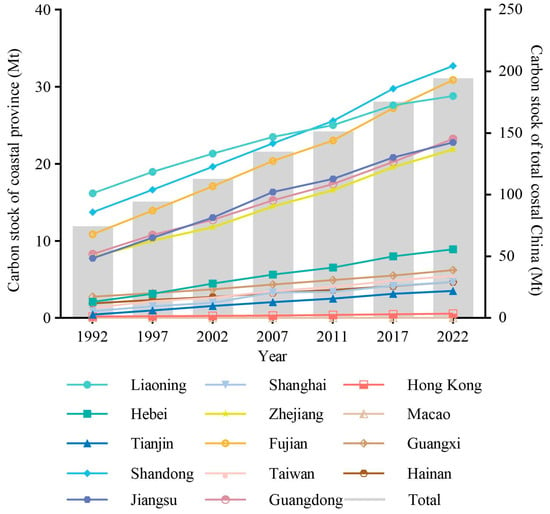
Figure 6.
Change of carbon stock from 1992 to 2022 for all coastal China and each coastal province.
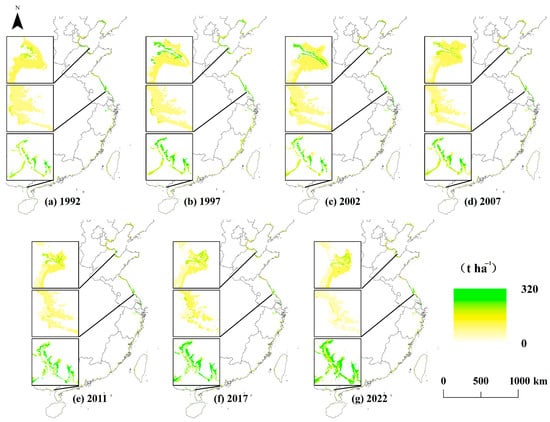
Figure 7.
Spatial distribution of carbon stock of blue carbon ecosystems in coastal China from 1992–2022.
3.4. Driving Force of Carbon Stock Changes
The change of carbon stock in blue carbon ecosystems in coastal China in the past three decades was attributable to a combination of natural and anthropogenic factors. Among these factors, the NDVI dominated its impacts, with the highest q value reaching 0.63, followed by precipitation (0.29) and temperature (0.18). The slightly higher q value for temperature compared with GDP and population density (q = 0.16 each) suggests a modestly stronger climatic effect. High NDVI values coincide with mangrove and salt-marsh stands in low-latitude provinces, underlining vegetation structure as a key mediator of carbon sequestration. In addition, the synergistic interaction of two factors was projected to enhance the effects than any individual factor. Taking the carbon stock change during 2002–2011 as an example (Figure 8), the interaction effect of NDVI with other factors is the most pronounced, exceeding or being equivalent to the effect of NDVI in isolation. Specifically, the highest spatial-association score occurs for NDVI combined with precipitation (q = 0.70), followed by NDVI with temperature (q = 0.66), indicating that areas where dense vegetation coincides with abundant rainfall (or higher temperature) exhibit the greatest similarity in the spatial pattern of carbon stock change. Furthermore, the interactions of NDVI with anthropogenic factors also exhibited significant enhancement effects on carbon storage capacity. For example, the combination of NDVI and population density attained a high spatial-association score (q = 0.64). This reflects the fact that many intensive mangrove and salt marsh restoration sites, characterized by high NDVI and high carbon density, have been located close to densely populated coastal cities, such as in Guangdong, Guangxi, and Fujian, for the past decades.
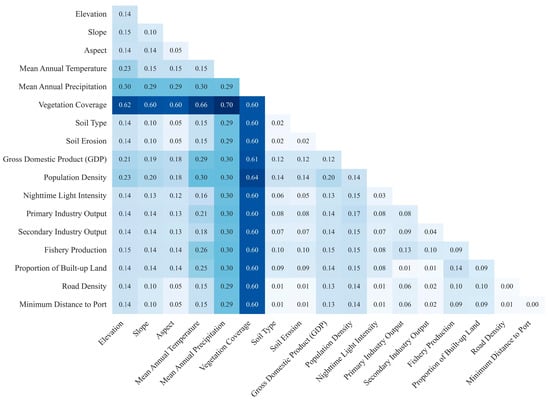
Figure 8.
Interaction of driving factors for carbon stock change in blue carbon ecosystems of coastal China during 2002–2011.
4. Discussion
4.1. Dynamics of Blue Carbon Ecosystems and Their Carbon Stocks
This research evaluated the dynamic evolution of blue carbon ecosystems and their carbon stocks in coastal China over the past decades based on a Landsat–GEE reconstruction. Results indicated that the blue carbon stock almost tripled—from 74 Mt C (1992) to 194 Mt C (2022), with pronounced blue ecosystem shifts. For example, mariculture has expanded by 44%; mangroves and salt marshes, showing fluctuating upward trends, gained modest area, while tidal flats shrank by nearly 39% (Figure 3). It should be noted that our analysis is confined to standing carbon stocks and did not estimate carbon emissions that may occur when tidal flats were converted; therefore, the stock increase reported here should not be interpreted as a net carbon sequestration. Transition analysis showed that mangrove area increased by 1059 km2 during 1992–2022, chiefly by colonizing former mariculture, water, tidal flats, and cropland. Over the same period, 812 km2 of older mangrove stands were lost, primarily to new mariculture, yielding a net gain of 247 km2 in the past 30 years. This expansion of mangrove carbon contrasts with the global net mangrove carbon decline of 1.8% between 1996 and 2016 [72] and indicates that Chinese restoration and afforestation initiatives have more than offset local development-related losses. The result of tidal flat losses agreed with the 1986–2018 national mapping [73], while the reduction amplitude during 1992–2022 was much greater than that from 1986 to 2018. These losses could be linked to aggressive reclamation for mariculture and industry (Figure 4). In addition, the sustained growth of mariculture we observed shows its increasingly visible role in the national blue carbon account. It should be noticed that although the net gained areas, the contribution of carbon sink of mariculture is also impacted by how much biomass is ultimately retained in shells, sediments, or long-lived products; for example, in some regions, mariculture replaces tidal flats and a local carbon deficit may still occur (Figure 7). Hence, in future studies, it is necessary to quantify and distinguish the ultimate sequestration efficiency of shellfish and seaweed cultivation by determining the proportion of the cultured carbon back to the atmosphere through harvesting, processing, and consumption [74]. In terms of the spatial pattern, Liaoning, Shandong, Fujian, and Jiangsu were hot spots of carbon stock in coastal China, which coincided with the high-productivity zones highlighted in a recent coastal wetland carbon flux synthesis [75], reflecting that regional policy differences rather than latitude alone dictate China’s emerging blue carbon geography.
4.2. Natural and Anthropogenic Drivers of Carbon Stock Change and Their Management Implications
The GeoDetector analysis indicated that NDVI was the foremost control on spatial variance in carbon stock change in coastal China over the past decades. This dominance echoes recent detector studies in the Yellow River Delta [76], where vegetation cover explained the largest share of wetland carbon-sink variability. Similar conclusions were drawn for mangroves in Guangxi, China, where canopy density was the key driver influencing carbon stock [77]. Climatic variables—especially precipitation (q = 0.29) and temperature (q = 0.18)—ranked immediately behind NDVI as predictors of blue carbon stock change. Warmer air temperature and sea-surface temperatures (SST) can release the constraints of mangrove limit in middle- and high-latitude regions yet may exceed heat-tolerance thresholds in low-latitude stands, thereby restructuring the mangrove–salt-marsh ecotone [78,79]. Precipitation modulates pore-water salinity and nutrient availability, further influencing mangrove growth [80]. Although sea-level rise (SLR) interacts with local elevation and slope to facilitate landward migration, explicit SLR or SST fields were beyond our analysis and warrant further study. Given the continuing recording heatwaves and increasingly erratic rainfall patterns in coastal China in recent years, the vulnerability of blue carbon stocks to future climate extremes is likely to escalate [81]. The effect of anthropogenic factors should not be ignored, although individual factors showed weaker effects. For instance, tidal-flat reclamation in Jiangsu was one of the principal anthropogenic drains on blue carbon loss since the 1980s [82]. Moreover, the interaction effects were critical; for example, NDVI × precipitation had the highest explanatory power, up to 0.70, indicating that densely vegetated areas receiving abundant monsoonal rainfall tend to retain more blue carbon. These driving mechanisms underscore the need for efficient coastal zone governance policies, such as expanding ecological red lines that prohibit further reclamation of high-productivity blue carbon ecosystems like salt marshes and mangroves. Priority actions should therefore include climate-smart, site-specific restoration of mangroves and salt marshes—using locally adapted and genetically diverse stock selected for heat and salinity tolerance and matched to the sediment budget and hydrodynamic setting [83,84], as well as developing mariculture paired with low-impact, multispecies “blue carbon aquaculture”. Embedding blue carbon habitats in China’s carbon market architecture to help fund sustained observation systems and responsive governance in facing the intensifying climate stress.
4.3. Uncertainty and Future Research
Accurate classification of land use is challenging given the complexity and diversity of coastal landscapes. This study constructed multiple classification combinations with different input variables, ntree, and mtry, and selected the one with the marginally best performance to improve the classification accuracy, with OA exceeding 92% and the Kappa coefficient exceeding 0.90. Future research could employ attempts, such as carrying out a five-fold cross validation, to further confirm the robustness. However, our 30 m Landsat classifications are likely to inevitably miss such as narrow fringing salt marshes and fragmented mangroves, contributing to conservative area estimates of blue carbon ecosystems. Also, Landsat imagery cannot consistently resolve the narrow, turbid, and often sub-tidal seagrass meadows along China’s coast; these blue carbon ecosystems were not included in this study. Based on the recent field and bibliometric analyses on seagrass meadows [51,85], we estimated an omitted carbon stock of nearly 1.40 Mt C, less than 1% of the national blue carbon stock reported in this study. However, it may be potentially significant in localized seagrass strongholds. In addition, feature importance ranking in this study was derived from a model trained across the entire coastal regions of China, which may mask local spectral or textural idiosyncrasies. In future work, we should integrate multi-source data such as Sentinel-2 MSI (10 m) and UAV-LiDAR to refine each habitat boundary to further improve the monitoring and management of blue carbon ecosystems [86]. Although stratified random sampling was used to spread training and test samples across the whole of coastal China, residual spatial autocorrelation may still inflate accuracy; an external independent validation should be conducted in future work to further verify model transferability. In addition, developing province-level (or estuary-level) classifiers and comparing their variable importance profiles could further improve classification accuracy. It also should be recognized that a portion of the recorded mangrove gain arises from coast-pushing projects—seaward planting that converts tidal flats or water into new stands—while some landward fringes continue to be lost to development; so the increase represents spatial relocation rather than classical reafforestation and may compress other intertidal habitats. In addition, many uncertainties and limitations exist in the quantification of carbon stock. First, the carbon density data used in this study were sourced from bibliometric analyses since the difficulty in obtaining local field data in such a large-scale study region (Table 2, Table 3, Tables S1 and S2), which introduces uncertainty in carbon stock estimations. Second, the InVEST is a static stock model; it omits lateral dissolved organic carbon/particulate organic carbon export, inorganic carbon burial, post-harvest aquaculture emissions, and dynamic responses to sea-level rise [87,88]. The shellfish carbonate could not be accurately captured only by InVEST. In addition, the proportion of carbon buried constitutes released to the atmosphere should be distinguished to determine the net carbon sink of shellfish since the rapid increase in mariculture occurred in coastal China over the past 30 years. Our sensitivity analysis confirmed that carbon density input played a much more important role as an uncertainty driver than land use class reassignment (Table S4), the accuracy of carbon density data would obviously affect the carbon stock assessment results, which underscoring the need for additional soil-core sampling, soil-thickness layers, and coupling with process-based wetland models for finer-scale planning. Moreover, this study focused on the spatiotemporal change in standing carbon stocks. It did not track the flows of carbon, nor the sediment and biomass accumulation rates that build new stock, nor the carbon emissions or lateral exports, such as tidal flat sediments that are eroded, or drained during conversion, that reduce it. Future work should couple land use change maps with process-based sediment carbon models, eddy covariance flux measurements, and life cycle assessments to derive full carbon balance estimations. Third, our attribution analysis highlighted the joint effects of natural and anthropogenic factors on carbon stock change in the past decades. Further studies could be carried out in simulating coastal blue carbon trajectories and vulnerability in the 21st century, considering alternative reclamation, restoration, and mariculture policies with the combinations of land-change simulators (PLUS, CLUE-S) and CMIP6 climate scenarios [89]. Moreover, the current driver analysis uses nationally uniform factors, so it cannot resolve inter-provincial differences in the relative influence of natural and anthropogenic factors. Future studies should compile province-specific analyses to disentangle these regional contrasts. Fourth, mean annual temperature covaries with latitude along the coast of China; part of its explanatory power may reflect broader spatial gradients. Future studies could further apply approaches such as spatial autoregressive or eigenvector-based to partition pure effects of climatic drivers from latitude more explicitly [90]. Moreover, our 30 m, 30-year raster analysis may still retain residual spatial confounding, such as NDVI and precipitation, which could inflate the apparent importance of some predictors. Further studies should incorporate models such as spatial weight matrices and Bayesian Spatial Autoregressive to help separate spatial dependence from natural and anthropogenic drivers [91].
5. Conclusions
This study generated several principal insights. First, rapid and divergent land use change reshaped the coastal blue carbon ecosystems in coastal China over the past three decades. Mariculture expanded by 44% during 1992–2022 (from 13,528 km2 to 19,501 km2), becoming the dominant blue carbon land use. While tidal flats contracted by 39%, primarily through reclamation for mariculture and industrial zones. Mangroves and salt marshes showed fluctuating upward trends and gained modest area, reflecting regional restoration and protection efforts. Second, the total carbon stock of blue carbon ecosystems almost tripled, rising markedly from 74 Mt C to 194 Mt C. Liaoning, Shandong, and Fujian accounted for nearly 50% of the total stock in coastal China, Fujian, Liaoning, Jiangsu, and Guangdong showed higher increasing trends, reflecting hotspots of carbon sink potential in coastal China. Third, vegetation coverage was the primary driver of spatial variation in carbon stock change, amplified by climate change and anthropogenic pressures. NDVI dominated its influence on the spatial variation in carbon stock change (q = 0.63), precipitation and temperature were the leading climatic co-factors, and the impact of anthropogenic factors was relatively weaker. The interaction between factors generated amplification effects, e.g., NDVI × precipitation, enhancing the effects on spatial variance of carbon stock than the single factor. These patterns illustrated that the natural conditions, policy interventions, and human activities jointly shaped provincial-specific blue carbon budgets. For example, warm and humid provinces such as Guangdong and Fujian possess carbon-dense mangroves and have made heavy efforts in many restoration programs, thus showing a higher increasing trend of carbon stock. Northern provinces such as Shandong and Jiangsu have long, sediment-rich coastlines where extensive salt marsh and tidal flats dominate the total stock, contributing an important role to the national blue carbon stock. These high-GDP and densely populated provinces also allocate more resources and funds to green belt and mangrove rehabilitation, creating more carbon stock. Conversely, in some provinces where ecological protection policies were not strictly implemented, sufficient resources are not invested in blue carbon conservation, or some blue carbon systems are converted into construction land during the urbanization process, their total or increment of blue carbon stock may be lower than that of other provinces. Effective efforts should be taken to protect, manage, and restore the blue carbon ecosystems in coastal China, such as expanding ecological red lines, scaling up climate-smart restoration on mangrove and salt marshes, afforestation, developing mariculture paired with low-impact, and so on.
Supplementary Materials
The following supporting information can be downloaded at: https://www.mdpi.com/article/10.3390/rs17152559/s1, Table S1: Carbon density data of tidal flats in coastal China; Table S2: Carbon density data of mariculture in coastal China; Table S3: The number of reference points used for training and validation for each land use type from 1992 to 2022; Table S4: Results of sensitivity analysis; Figure S1: Spatial distribution of Landsat Worldwide Reference System 2 (WRS-2) paths covering the study area and total observations (a) and high-quality available observations (b) of Landsat TM/OLI images; Figure S2: The importance ranking of 17 variables for land use classification; Figure S3: Land use classification of coastal China in 2022; Figure S4: Provincial area and its proportion of different blue carbon ecosystems in coastal China in 2022.
Author Contributions
Conceptualization, J.C.; methodology, J.C., Y.L. and F.L.; software, Y.L. and F.L.; validation, F.L.; formal analysis, J.C., Y.L., F.L. and M.X.; writing—original draft preparation, J.C. and Y.L.; writing—review and editing, J.C.; visualization, J.C., Y.L. and F.L.; supervision, G.G.; project administration, J.C.; funding acquisition, J.C. All authors have read and agreed to the published version of the manuscript.
Funding
This research was funded by the National Key Research and Development Program of China (Grant No. 2022YFC3106003), the National Natural Science Foundation of China (Grant No. 42301087), the Science and Technology Innovation Plan of Shanghai Science and Technology Commission (Grant No. 24692103000), the Shanghai Sailing Program (Grant No. 23YF1416400), the grant from State Key Laboratory of Resources and Environmental Information System, and the Startup Foundation for Young Teachers of Shanghai Ocean University.
Data Availability Statement
The data supporting the conclusions of this article will be made available by the authors on request.
Conflicts of Interest
The authors declare no conflicts of interest.
References
- Macreadie, P.I.; Anton, A.; Raven, J.A.; Beaumont, N.; Connolly, R.M.; Friess, D.A.; Kelleway, J.J.; Kennedy, H.; Kuwae, T.; Lavery, P.S.; et al. The future of Blue Carbon science. Nat. Commun. 2019, 10, 3988. [Google Scholar] [CrossRef]
- Serrano, O.; Kelleway, J.J.; Lovelock, C.; Lavery, P.S. Conservation of blue carbon ecosystems for climate change mitigation and adaptation. Coast. Wetl. 2019, 28, 965–996. [Google Scholar]
- Arkema, K.K.; Guannel, G.; Verutes, G.; Wood, S.A.; Guerry, A.; Ruckelshaus, M.; Kareiva, P.; Lacayo, M.; Silver, J.M. Coastal habitats shield people and property from sea-level rise and storms. Nat. Clim. Change 2013, 3, 913–918. [Google Scholar] [CrossRef]
- Bertram, C.; Quaas, M.; Reusch, T.B.H.; Vafeidis, A.T.; Wolff, C.; Rickels, W. The blue carbon wealth of nations. Nat. Clim. Change 2021, 11, 704–709. [Google Scholar] [CrossRef]
- Raven, J. Blue carbon: Past, present and future, with emphasis on macroalgae. Biol. Lett. 2018, 14, 20180336. [Google Scholar] [CrossRef]
- Brown, D.R.; Marotta, H.; Peixoto, R.B.; Enrich-Prast, A.; Barroso, G.C.; Soares, M.L.G.; Machado, W.; Perez, A.; Smoak, J.M.; Sanders, L.M.; et al. Hypersaline tidal flats as important “blue carbon” systems: A case study from three ecosystems. Biogeosciences 2021, 18, 2527–2538. [Google Scholar] [CrossRef]
- Zhong, C.; Li, T.; Bi, R.; Sanganyado, E.; Huang, J.; Jiang, S.; Zhang, Z.; Du, H. Systematic overview, trends and global perspectives on blue carbon: A bibliometric study (2003–2021). Ecol. Indic. 2023, 148, 110063. [Google Scholar] [CrossRef]
- Gao, G.; Beardall, J.; Jin, P.; Gao, L.; Xie, S.Y.; Gao, K.S. A review of existing and potential blue carbon contributions to climate change mitigation in the Anthropocene. J. Appl. Ecol. 2022, 59, 1686–1699. [Google Scholar] [CrossRef]
- Lovelock, C.E.; Reef, R. Variable Impacts of Climate Change on Blue Carbon. One Earth 2020, 3, 195–211. [Google Scholar] [CrossRef]
- Cuellar-Martinez, T.; Ruiz-Fernández, A.C.; Sanchez-Cabeza, J.A.; Pérez-Bernal, L.; López-Mendoza, P.G.; Carnero-Bravo, V.; Agraz-Hernández, C.M.; van Tussenbroek, B.I.; Sandoval-Gil, J.; Cardoso-Mohedano, J.G.; et al. Temporal records of organic carbon stocks and burial rates in Mexican blue carbon coastal ecosystems throughout the Anthropocene. Glob. Planet. Change 2020, 192, 103215. [Google Scholar] [CrossRef]
- Cooley, S.; Schoeman, D.; Bopp, L.; Boyd, P.; Donner, S.; Ito, S.I.; Kiessling, W.; Martinetto, P.; Ojea, E.; Racault, M.F.; et al. Oceans and Coastal Ecosystems and Their Services. In Climate Change 2022: Impacts, Adaptation and Vulnerability. Contribution of Working Group II to the Sixth Assessment Report of the Intergovernmental Panel on Climate Change; Cambridge University Press: Cambridge, UK; New York, NY, USA, 2022. [Google Scholar]
- Quevedo, J.M.D.; Uchiyama, Y.; Kohsaka, R. Progress of blue carbon research: 12 years of global trends based on content analysis of peer-reviewed and ‘gray literature’ documents. Ocean Coast. Manag. 2023, 236, 106495. [Google Scholar] [CrossRef]
- Sun, Y.Z.; Zhang, H.K.; Lin, Q.; Zhang, C.X.; He, C.; Zheng, H.P. Exploring the international research landscape of blue carbon: Based on scientometrics analysis. Ocean Coast. Manag. 2024, 252, 107106. [Google Scholar] [CrossRef]
- Arnaud, M.; Krause, S.; Norby, R.J.; Dang, T.H.; Acil, N.; Kettridge, N.; Gauci, V.; Ullah, S. Global mangrove root production, its controls and roles in the blue carbon budget of mangroves. Glob. Change Biol. 2023, 29, 3256–3270. [Google Scholar] [CrossRef]
- Song, S.; Ding, Y.; Li, W.; Meng, Y.; Zhou, J.; Gou, R.; Zhang, C.; Ye, S.; Saintilan, N.; Krauss, K.W.; et al. Mangrove reforestation provides greater blue carbon benefit than afforestation for mitigating global climate change. Nat. Commun. 2023, 14, 756. [Google Scholar] [CrossRef]
- Campbell, A.D.; Fatoyinbo, L.; Goldberg, L.; Lagomasino, D. Global hotspots of salt marsh change and carbon emissions. Nature 2022, 612, 701–706. [Google Scholar] [CrossRef] [PubMed]
- Johannessen, S.C. How can blue carbon burial in seagrass meadows increase long-term, net sequestration of carbon? A critical review. Environ. Res. Lett. 2022, 17, 093004. [Google Scholar] [CrossRef]
- Bunting, P.; Rosenqvist, A.; Hilarides, L.; Lucas, R.M.; Thomas, N.; Tadono, T.; Worthington, T.A.; Spalding, M.; Murray, N.J.; Rebelo, L.M. Global Mangrove Extent Change 1996–2020: Global Mangrove Watch Version 3.0. Remote Sens. 2022, 14, 3657. [Google Scholar] [CrossRef]
- McKenzie, L.J.; Langlois, L.A.; Roelfsema, C.M. Improving Approaches to Mapping Seagrass within the Great Barrier Reef: From Field to Spaceborne Earth Observation. Remote Sens. 2022, 14, 2604. [Google Scholar] [CrossRef]
- Chen, Z.L.; Lee, S.Y. Tidal Flats as a Significant Carbon Reservoir in Global Coastal Ecosystems. Front. Mar. Sci. 2022, 9, 900896. [Google Scholar] [CrossRef]
- Xu, C.J.; Su, G.H.; Zhao, K.S.; Wang, H.; Xu, X.Q.; Li, Z.Q.; Hu, Q.; Xu, J. Assessment of greenhouse gases emissions and intensity from Chinese marine aquaculture in the past three decades. J. Environ. Manag. 2023, 329, 117025. [Google Scholar] [CrossRef]
- Human, L.R.D.; Els, J.; Wasserman, J.; Adams, J.B. Blue carbon and nutrient stocks in salt marsh and seagrass from an urban African estuary. Sci. Total Environ. 2022, 842, 156955. [Google Scholar] [CrossRef]
- Li, P.; Liu, D.H.; Liu, C.; Li, X.X.; Liu, Z.H.; Zhu, Y.J.; Peng, B. Blue carbon development in China: Realistic foundation, internal demands, and the construction of blue carbon market trading mode. Front. Mar. Sci. 2024, 10, 1310261. [Google Scholar] [CrossRef]
- Pham, T.D.; Yokoya, N.; Bui, D.T.; Yoshino, K.; Friess, D.A. Remote Sensing Approaches for Monitoring Mangrove Species, Structure, and Biomass: Opportunities and Challenges. Remote Sens. 2019, 11, 230. [Google Scholar] [CrossRef]
- Sasmito, S.D.; Taillardat, P.; Clendenning, J.N.; Cameron, C.; Friess, D.A.; Murdiyarso, D.; Hutley, L.B. Effect of land-use and land-cover change on mangrove blue carbon: A systematic review. Glob. Change Biol. 2019, 25, 4291–4302. [Google Scholar] [CrossRef] [PubMed]
- Rogers, K.; Lymburner, L.; Salum, R.; Brooke, B.P.; Woodroffe, C.D. Mapping of mangrove extent and zonation using high and low tide composites of Landsat data. Hydrobiologia 2017, 803, 49–68. [Google Scholar] [CrossRef]
- Roy, A.D.; Arachchige, P.S.P.; Watt, M.S.; Kale, A.; Davies, M.; Heng, J.E.; Daneil, R.; Galgamuwa, G.A.P.; Moussa, L.G.; Ewane, E.B.; et al. Remote sensing-based mangrove blue carbon assessment in the Asia-Pacific: A systematic review. Sci. Total Environ. 2024, 938, 173270. [Google Scholar]
- Bajaj, M.; Sasaki, N.; Tsusaka, T.W.; Venkatappa, M.; Abe, I.; Shrestha, R.P. Assessing changes in mangrove forest cover and carbon stocks in the Lower Mekong Region using Google Earth Engine. Innov. Green Dev. 2024, 3, 100140. [Google Scholar] [CrossRef]
- Donato, D.C.; Kauffman, J.B.; Murdiyarso, D.; Kurnianto, S.; Stidham, M.; Kanninen, M. Mangroves among the most carbon-rich forests in the tropics. Nat. Geosci. 2011, 4, 293–297. [Google Scholar] [CrossRef]
- Gonzalez-Garcia, A.; Arias, M.; Garcia-Tiscar, S.; Alcorlo, P.; Santos-Martin, F. National blue carbon assessment in Spain using InVEST: Current state and future perspectives. Ecosyst. Serv. 2022, 53, 101397. [Google Scholar] [CrossRef]
- Kotagama, O.W.; Pathirage, S.; Perera, K.A.R.S.; Dahanayaka, D.D.G.L.; Miththapala, S.; Somarathne, S. Modelling predictive changes of blue carbon due to sea-level rise using InVEST model in Chilaw Lagoon, Sri Lanka. Model. Earth Syst. Environ. 2023, 9, 585–599. [Google Scholar] [CrossRef]
- Jiao, N.; Wang, H.; Xu, G.; Arico, S. Blue carbon on the rise: Challenges and opportunities. Natl. Sci. Rev. 2018, 5, 464–468. [Google Scholar] [CrossRef]
- Sasmito, S.D.; Sillanpaa, M.; Hayes, M.A.; Bachri, S.; Saragi-Sasmito, M.F.; Sidik, F.; Hanggara, B.B.; Mofu, W.Y.; Rumbiak, V.I.; Hendri; et al. Mangrove blue carbon stocks and dynamics are controlled by hydrogeomorphic settings and land-use change. Glob. Change Biol. 2020, 26, 3028–3039. [Google Scholar] [CrossRef]
- Liu, Z.; Deng, Z.; He, G.; Wang, H.L.; Zhang, X.; Lin, J.; Qi, Y.; Liang, X. Challenges and opportunities for carbon neutrality in China. Nat. Rev. Earth Environ. 2022, 3, 141–155. [Google Scholar] [CrossRef]
- Meng, W.; Feagin, R.A.; Hu, B.; He, M.; Li, H. The spatial distribution of blue carbon in the coastal wetlands of China. Estuar. Coast. Shelf Sci. 2019, 222, 13–20. [Google Scholar] [CrossRef]
- Gu, T.; Ng, C.C. Utilising coastal blue carbon (CBC) to mitigate the climate crisis: Current status and future analysis of China. Ocean Coast. Manag. 2025, 266, 107699. [Google Scholar] [CrossRef]
- Meng, Y.; Gou, R.; Bai, J.; Moreno-Mateos, D.; Davis, C.C.; Wan, L.; Song, S.; Zhang, H.; Zhu, X.; Lin, G. Spatial patterns and driving factors of carbon stocks in mangrove forests on Hainan Island, China. Glob. Ecol. Biogeogr. 2022, 31, 1692–1706. [Google Scholar] [CrossRef]
- Yu, C.; Feng, J.; Liu, K.; Wang, G.; Zhu, Y.; Cheng, H.; Guan, D. Changes of ecosystem carbon stock following the plantation of exotic mangrove Sonneratia apetala in Qi’ao Island, China. Sci. Total Environ. 2020, 717, 137142. [Google Scholar] [CrossRef] [PubMed]
- LIu, S.; Wang, L.; Zhang, J.; Ding, S.P. Opposite effect on soil organic carbon between grain and non-grain crops: Evidence from Main Grain Land, China. Agric. Ecosyst. Environ. 2025, 379, 109364. [Google Scholar] [CrossRef]
- Thurner, M.; Beer, C.; Santoro, M.; Carvalhais, N.; Wutzler, T.; Schepaschenko, D.; Shvidenko, A.; Kompter, E.; Ahrens, B.; Levick, S.R.; et al. Carbon stock and density of northern boreal and temperate forests. Glob. Ecol. Biogeogr. 2014, 23, 297–310. [Google Scholar] [CrossRef]
- Huang, Y.H.; Lee, C.L.; Chung, C.Y.; Hsiao, S.C.; Lin, H.J. Carbon budgets of multispecies seagrass beds at Dongsha Island in the South China Sea. Mar. Environ. Res. 2015, 106, 92–102. [Google Scholar] [CrossRef]
- Cai, T.; Huang, S.; Wu, J.; Zhang, Z.; Xue, C.; Chen, Y. Saltmarsh Carbon Stock Changes under Combined Effects of Vegetation Succession and Reclamation. Ecosyst. Health Sustain. 2023, 9, 0114. [Google Scholar] [CrossRef]
- Wang, F.; Sanders, C.J.; Santos, I.R.; Tang, J.; Schuerch, M.; Kirwan, M.L.; Kopp, R.E.; Zhu, K.; Li, X.; Yuan, J.; et al. Global blue carbon accumulation in tidal wetlands increases with climate change. Natl. Sci. Rev. 2021, 8, nwaa296. [Google Scholar] [CrossRef]
- Sun, X.; Filgueira, R.; Sun, Y.; Han, M.; Tang, Q.; Sun, Y. Intensive oyster farming enhances carbon storage in sediments over decades. Commun. Earth Environ. 2025, 6, 383. [Google Scholar] [CrossRef]
- Kwan, V.; Fong, J.; Ng, C.S.L.; Huang, D. Temporal and spatial dynamics of tropical macroalgal contributions to blue carbon. Sci. Total Environ. 2022, 828, 154369. [Google Scholar] [CrossRef]
- Krause-Jensen, D.; Duarte, C.M. Substantial role of macroalgae in marine carbon sequestration. Nat. Geosci. 2016, 9, 737–742. [Google Scholar] [CrossRef]
- Feng, J.C.; Sun, L.; Yan, J. Carbon sequestration via shellfish farming: A potential negative emissions technology. Renew. Sustain. Energy Rev. 2023, 171, 113018. [Google Scholar] [CrossRef]
- Gorelick, N.; Hancher, M.; Dixon, M.; Ilyushchenko, S.; Thau, D.; Moore, R. Google Earth Engine: Planetary-scale geospatial analysis for everyone. Remote Sens. Environ. 2017, 202, 18–27. [Google Scholar] [CrossRef]
- Chen, C.; Yang, X.B.; Jiang, S.H.; Liu, Z.S. Mapping and spatiotemporal dynamics of land-use and land-cover change based on the Google Earth Engine cloud platform from Landsat imagery: A case study of Zhoushan Island, China. Heliyon 2023, 9, e19654. [Google Scholar] [CrossRef] [PubMed]
- Campillo-Tamarit, N.; Molner, J.V.; Soria, J.M. Remote Sensing Tools for Monitoring Marine Phanerogams: A Review of Sentinel and Landsat Applications. J. Mar. Sci. Eng. 2025, 13, 292. [Google Scholar] [CrossRef]
- Unsworth, R.K.F.; Cullen-Unsworth, L.C.; Jones, B.L.H.; Lilley, R.J. The planetary role of seagrass conservation. Science 2022, 377, 609–613. [Google Scholar] [CrossRef]
- Wang, F.; Liu, J.; Qin, G.; Zhang, J.; Zhou, J.; Wu, J.; Ren, H. Coastal blue carbon in China as a nature-based solution toward carbon neutrality. Innovation 2023, 4, 100481. [Google Scholar] [CrossRef]
- Pinkeaw, S.; Boonrat, P.; Koedsin, W.; Huete, A. Semi-automated mangrove mapping at National-Scale using Sentinel-2, Sentinel-1, and SRTM data with Google Earth Engine: A case study in Thailand. Egypt. J. Remote Sens. Space Sci. 2024, 27, 555–564. [Google Scholar] [CrossRef]
- Zhang, Q.; Zhang, G.L.; Xiao, X.M.; Zhang, Y.; You, N.S.; Di, Y.Y.; Yang, T.; He, Y.L.; Dong, J.W. Unraveling the spatial-temporal patterns of typhoon impacts on maize during the milk stage in Northeast China in 2020. Eur. J. Agron. 2024, 156, 127169. [Google Scholar] [CrossRef]
- Amindin, A.; Siamian, N.; Kariminejad, N.; Clague, J.J.; Pourghasemi, H.R. An integrated GEE and machine learning framework for detecting ecological stability under land use/land cover changes. Glob. Ecol. Conserv. 2024, 53, e03010. [Google Scholar] [CrossRef]
- Aji, M.A.P.; Kamal, M.; Farda, N.M. Mangrove species mapping through phenological analysis using random forest algorithm on Google Earth Engine. Remote Sens. Appl. Soc. Environ. 2023, 30, 100978. [Google Scholar] [CrossRef]
- Bera, D.; Das Chatterjee, N.; Bera, S.; Ghosh, S.; Dinda, S. Comparative performance of Sentinel-2 MSI and Landsat-8 OLI data in canopy cover prediction using Random Forest model: Comparing model performance and tuning parameters. Adv. Space Res. 2023, 71, 4691–4709. [Google Scholar] [CrossRef]
- Nelson, E.; Sander, H.; Hawthorne, P.; Conte, M.; Ennaanay, D.; Wolny, S.; Manson, S.; Polasky, S. Projecting Global Land-Use Change and Its Effect on Ecosystem Service Provision and Biodiversity with Simple Models. PLoS ONE 2010, 5, e14327. [Google Scholar] [CrossRef]
- Li, Y.; Qiu, J.H.; Li, Z.; Li, Y.F. Assessment of Blue Carbon Storage Loss in Coastal Wetlands under Rapid Reclamation. Sustainability 2018, 10, 2818. [Google Scholar] [CrossRef]
- Yuan, Y.Q.; Li, X.Z.; Jiang, J.Y.; Xue, L.M.; Craft, C.B. Distribution of organic carbon storage in different salt-marsh plant communities: A case study at the Yangtze Estuary. Estuar. Coast. Shelf Sci. 2020, 243, 106900. [Google Scholar] [CrossRef]
- Shi, X.; Wu, L.; Zheng, Y.Q.; Zhang, X.; Wang, Y.J.; Chen, Q.; Sun, Z.Y.; Nie, T.Z. Dynamic Estimation of Mangrove Carbon Storage in Hainan Island Based on the InVEST-PLUS Model. Forests 2024, 15, 750. [Google Scholar] [CrossRef]
- Ke, L.; Lei, N.; Zhang, S.; Yin, C.; Lu, Y.; Wang, L.; Wang, Q. Estimation of blue carbon stock in the Liaohe Estuary wetland based on soil thickness and multi-scenario modeling. Ecol. Indic. 2025, 171, 113201. [Google Scholar] [CrossRef]
- Lai, Q.; Jia, M.; He, F.; Zhang, A.; Pei, D.; Yu, M. Current and Future Potential of Shellfish and Algae Mariculture Carbon Sinks in China. Int. J. Environ. Res. Public Health 2022, 19, 8873. [Google Scholar] [CrossRef] [PubMed]
- Wang, J.F.; Hu, Y. Environmental health risk detection with GeogDetector. Environ. Modell. Softw. 2012, 33, 114–115. [Google Scholar] [CrossRef]
- Huang, X.D.; Liu, X.Q.; Wang, Y. Spatio-Temporal Variations and Drivers of Carbon Storage in the Tibetan Plateau Under SSP-RCP Scenarios Based on the PLUS-InVEST-GeoDetector Model. Sustainability 2024, 16, 5711. [Google Scholar] [CrossRef]
- Li, Y.T.; Zhu, C.M.; Yang, R.M.; Xu, L.; Zhang, X. Spatial patterns of soil organic carbon stocks and its controls in Chinese grassland ecosystems. Geoderma 2024, 448, 116970. [Google Scholar] [CrossRef]
- Wang, Y.; Wang, M.; Zhang, J.R.; Wu, Y.M.; Zhou, Y. Assessment of carbon stocks and influencing factors in terrestrial ecosystems based on surface area. iScience 2024, 27, 111431. [Google Scholar] [CrossRef]
- Cai, J.H.; Chi, H.; Lu, N.; Bian, J.; Chen, H.Q.; Yu, J.K.; Yang, S.Q. Analysis of Spatiotemporal Predictions and Drivers of Carbon Storage in the Pearl River Delta Urban Agglomeration via the PLUS-InVEST-GeoDetector Model. Energies 2024, 17, 5093. [Google Scholar] [CrossRef]
- Wang, J.F.; Zhang, T.L.; Fu, B.J. A measure of spatial stratified heterogeneity. Ecol. Indic. 2016, 67, 250–256. [Google Scholar] [CrossRef]
- Wang, J.F.; Li, X.H.; Christakos, G.; Liao, Y.L.; Zhang, T.; Gu, X.; Zheng, X.Y. Geographical Detectors-Based Health Risk Assessment and its Application in the Neural Tube Defects Study of the Heshun Region, China. Int. J. Geogr. Inf. Sci. 2010, 24, 107–127. [Google Scholar] [CrossRef]
- Wang, J.; Xu, X. Geodetector: Principle and prospective. Acta Geogr. Sin. 2017, 72, 116–134. (In Chinese) [Google Scholar]
- Richards, D.R.; Thompson, B.S.; Wijedasa, L. Quantifying net loss of global mangrove carbon stocks from 20 years of land cover change. Nat. Commun. 2020, 11, 4260. [Google Scholar] [CrossRef]
- Wang, X.X.; Xiao, X.M.; Zou, Z.H.; Chen, B.Q.; Ma, J.; Dong, J.W.; Doughty, R.B.; Zhong, Q.Y.; Qin, Y.W.; Dai, S.Q.; et al. Tracking annual changes of coastal tidal flats in China during 1986–2016 through analyses of Landsat images with Google Earth Engine. Remote Sens. Environ. 2020, 238, 110987. [Google Scholar] [CrossRef] [PubMed]
- Guo, S.M.; Nie, H.T. Estimation of Mariculture Carbon Sinks in China and Its Influencing Factors. J. Mar. Sci. Eng. 2024, 12, 724. [Google Scholar] [CrossRef]
- Lu, W.Z.; Xiao, J.F.; Gao, H.Q.; Jia, Q.Y.; Li, Z.J.; Liang, J.; Xing, Q.H.; Mao, D.H.; Li, H.; Chu, X.J.; et al. Carbon fluxes of China’s coastal wetlands and impacts of reclamation and restoration. Glob. Change Biol. 2024, 30, e17280. [Google Scholar] [CrossRef] [PubMed]
- Tang, Z.X.; Wang, D.; Tian, X.P.; Bi, X.L.; Zhou, Z.X.; Luo, F.B.; Ning, R.R.; Li, J.R. Exploring the factors influencing the carbon sink function of coastal wetlands in the Yellow River Delta. Sci. Rep. 2024, 14, 28938. [Google Scholar] [CrossRef]
- Xie, Z.X.; Li, H.A.; Yuan, Y.; Hu, W.; Luo, G.; Huang, L.T.; Chen, M.; Wu, W.M.; Yan, G.L.; Sun, X. The spatial patterns and driving mechanisms of blue carbon ‘loss’ and ‘gain’ in a typical mangrove ecosystem: A case study of Beihai, Guangxi Province of China. Sci. Total Environ. 2023, 905, 167241. [Google Scholar] [CrossRef]
- Alongi, D.M. Impacts of Climate Change on Blue Carbon Stocks and Fluxes in Mangrove Forests. Forests 2022, 13, 149. [Google Scholar] [CrossRef]
- Saintilan, N.; Wilson, N.; Rogers, K. Mangrove expansion and salt-marsh decline at the mangrove–salt-marsh interface in south-east Australia. Glob. Change Biol. 2020, 26, 3058–3071. [Google Scholar]
- Simard, M.; Fatoyinbo, L.; Smetanka, C.; Rivera-Monroy, V.H.; Castañeda-Moya, E.; Thomas, N.; Van der Stocken, T. Mangrove canopy height globally related to precipitation, temperature and cyclone frequency. Nat. Geosci. 2019, 12, 40–45. [Google Scholar] [CrossRef]
- Yao, Y.L.; Wang, C.Z. Subsurface Marine Heatwaves in the South China Sea. J. Geophys. Res. Ocean. 2024, 129, e2024JC021356. [Google Scholar] [CrossRef]
- Chen, Y.; Li, G.; Cui, L.; Li, L.; He, L.; Ma, P. The effects of tidal flat reclamation on the stability of the coastal area in the Jiangsu Province, China, from the perspective of landscape structure. Land 2022, 11, 421. [Google Scholar] [CrossRef]
- Friess, D.A.; Rogers, K.; Lovelock, C.E.; Krauss, K.W.; Hamilton, S.E.; Lee, S.Y.; Lucas, R.; Primavera, J.; Rajkaran, A.; Shi, S.H. The State of the World’s Mangrove Forests: Past, Present, and Future. Annu. Rev. Environ. Resour. 2019, 44, 89–115. [Google Scholar] [CrossRef]
- Billah, M.M.; Bhuiyan, M.K.A.; Islam, M.A.; Das, J.; Hoque, A.T.M.R. Salt marsh restoration: An overview of techniques and success indicators. Environ. Sci. Pollut. Res. 2022, 29, 15347–15363. [Google Scholar] [CrossRef] [PubMed]
- Fu, C.C.; Li, Y.; Zeng, L.; Zhang, H.B.; Tu, C.; Zhou, Q.; Xiong, K.X.; Wu, J.P.; Duarte, C.M.; Christie, P.; et al. Stocks and losses of soil organic carbon from Chinese vegetated coastal habitats. Glob. Change Biol. 2021, 27, 202–214. [Google Scholar] [CrossRef] [PubMed]
- Lu, Y.; Chen, J.; Gao, G.; An, A.; Feng, J.; Liu, Z. Estimation of carbon stock in the reed wetland of Weishan county in China based on Sentinel satellite series. Carbon Res. 2025, 4, 29. [Google Scholar] [CrossRef]
- Tikuye, B.G.; Tefera, G.W.; Gurau, S.; Ray, R.L. Assessing carbon stock and sequestration potential under land use and land cover dynamics in the Upper Blue Nile River Basin, Ethiopia. Carbon Manag. 2025, 16, 2479516. [Google Scholar] [CrossRef]
- Mukhopadhyay, A.; Hati, J.P.; Acharyya, R.; Pal, I.; Tuladhar, N.; Habel, M. Global trends in using the InVEST model suite and related research: A systematic review. Ecohydrol. Hydrobiol. 2025, 25, 389–405. [Google Scholar] [CrossRef]
- Chen, J.; An, A.H.; Gao, G.P. A substantial reduction of total and group-specific population risk to compound heat and drought events in China through achieving carbon neutrality. J. Clean. Prod. 2025, 489, 144694. [Google Scholar] [CrossRef]
- Griffith, D.A.; Peres-Neto, P.R. Spatial modeling in ecology: The flexibility of eigenfunction spatial analyses. Ecology 2006, 87, 2603–2613. [Google Scholar] [CrossRef]
- Latimer, A.M.; Wu, S.S.; Gelfand, A.E.; Silander, J.A. Building statistical models to analyze species distributions. Ecol. Appl. 2006, 16, 33–50. [Google Scholar] [CrossRef]
Disclaimer/Publisher’s Note: The statements, opinions and data contained in all publications are solely those of the individual author(s) and contributor(s) and not of MDPI and/or the editor(s). MDPI and/or the editor(s) disclaim responsibility for any injury to people or property resulting from any ideas, methods, instructions or products referred to in the content. |
© 2025 by the authors. Licensee MDPI, Basel, Switzerland. This article is an open access article distributed under the terms and conditions of the Creative Commons Attribution (CC BY) license (https://creativecommons.org/licenses/by/4.0/).
